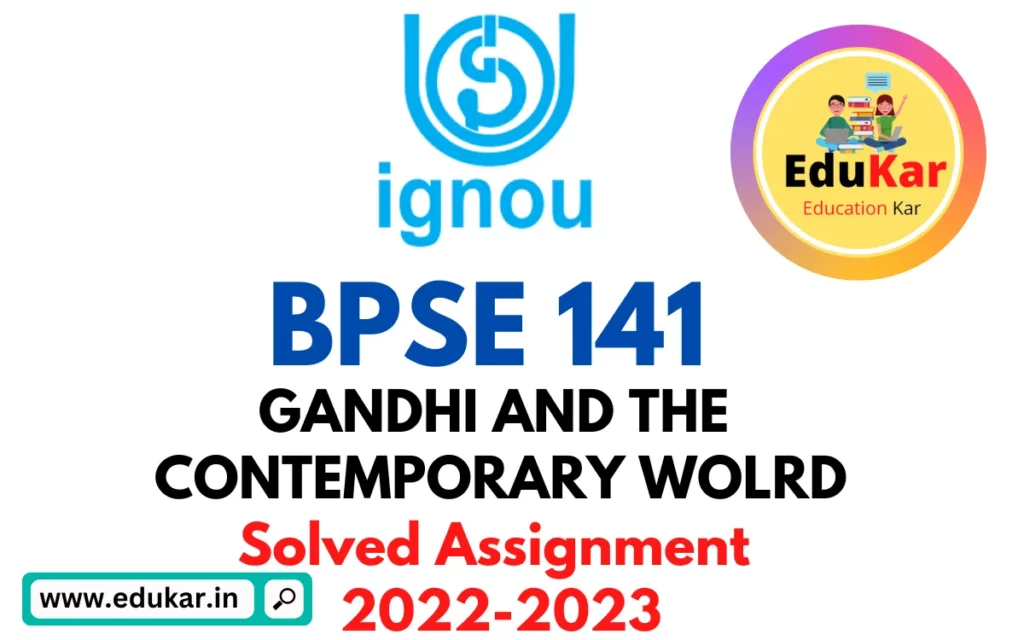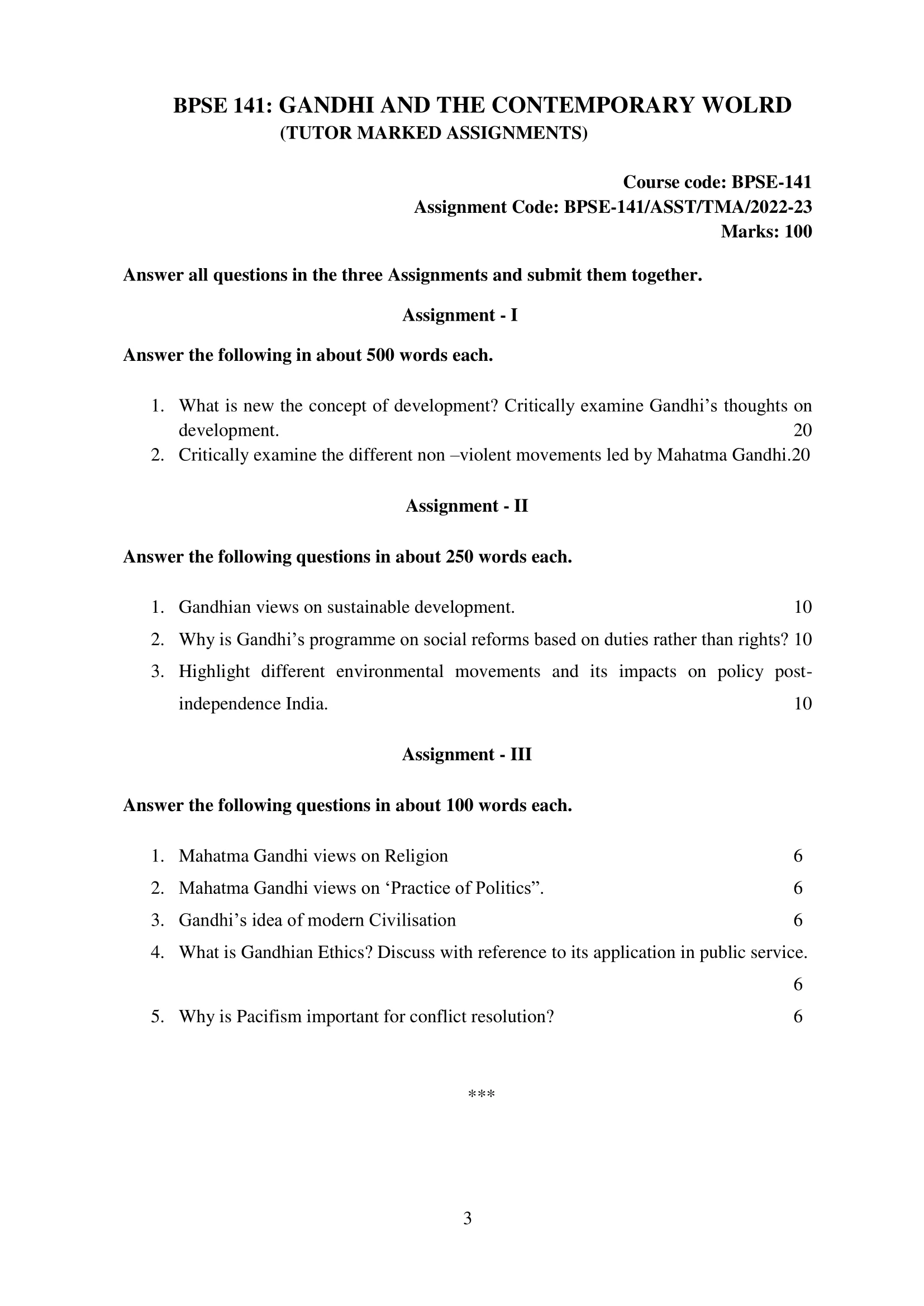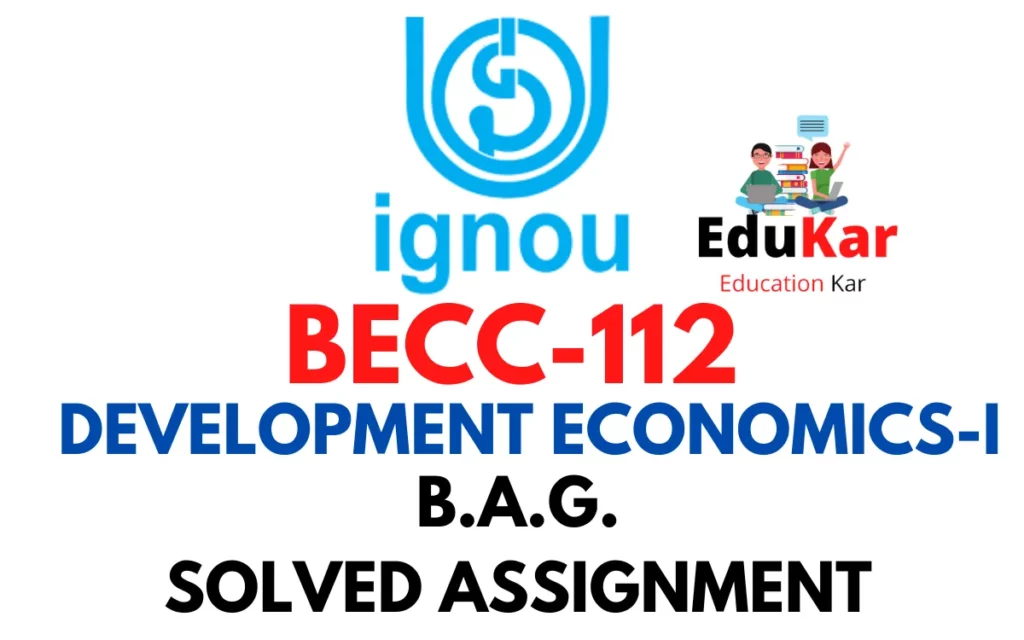Contents
- 1 Assignment – I
- 2 Answer the following in about 500 words each.
- 3 1. What is new the concept of development? Critically examine Gandhi’s thoughts on development.
- 4 2. Critically examine the different non –violent movements led by Mahatma Gandhi.
- 5 Assignment – II
- 6 Answer the following questions in about 250 words each.
- 7 1. Gandhian views on sustainable development.
- 8 2. Why is Gandhi’s programme on social reforms based on duties rather than rights?
- 9 3. Highlight different environmental movements and its impacts on policy postindependence India.
- 10 Assignment – III
- 11 Answer the following questions in about 100 words each.
- 12 1. Mahatma Gandhi views on Religion.
- 13 2. Mahatma Gandhi views on ‘Practice of Politics”.
- 14 3. Gandhi’s idea of modern Civilisation.
- 15 4. What is Gandhian Ethics? Discuss with reference to its application in public service.
- 16 5. Why is Pacifism important for conflict resolution?

| Title | BPSE 141: IGNOU BAG Solved Assignment 2022-2023 |
| University | IGNOU |
| Degree | Bachelor Degree Programme |
| Course Code | BPSE 141 |
| Course Name | GANDHI AND THE CONTEMPORARY WOLRD |
| Programme Name | Bachelor of Arts (General) |
| Programme Code | BAG |
| Total Marks | 100 |
| Year | 2022-2023 |
| Language | English |
| Assignment Code | BPSE-141/ASST/TMA/2022-23 |
| Last Date for Submission of Assignment: | For June Examination: 31st April For December Examination: 30th September |

Assignment – I
Answer the following in about 500 words each.
1. What is new the concept of development? Critically examine Gandhi’s thoughts on development.
Ans: The concept of development has evolved over time and is now understood to encompass more than just economic growth. Today, development is seen as a comprehensive process that aims to improve the overall well-being of people and communities, taking into account their economic, social, political, and environmental needs.
Gandhi, the father of the nation in India, had a unique perspective on development. He believed that development should be centered around people and their needs, rather than solely on economic growth and material prosperity. He saw the exploitation of people and nature as the root cause of poverty and suffering and believed that true development must be based on principles of equality, justice, and sustainability.
Gandhi’s thoughts on development emphasized the importance of local self-sufficiency, community empowerment, and decentralization of power. He believed that people should be able to control their own lives and resources and that development must be carried out in a way that respects the rights of individuals and communities. He saw the importance of a sustainable approach to development, one that does not compromise the ability of future generations to meet their own needs.
In contrast to the dominant development models of his time, Gandhi advocated for a non-violent, people-centered approach to development. He believed in the power of people to create positive change and that development should not be imposed from above but should be a bottom-up process in which people are actively involved in shaping their own future.
Gandhi’s views on development were deeply rooted in his philosophy of non-violent resistance and his belief in the power of the individual to bring about change. He saw the individual as the key agent of development, and believed that each person has the potential to bring about positive change in their own lives and in the lives of others.
Overall, Gandhi’s thoughts on development represent a departure from the traditional model of development and offer a unique and compelling vision for a more sustainable and just world. While many of his ideas may seem radical or unrealistic in the context of modern development, they continue to inspire and guide efforts to create more equitable and sustainable forms of development around the world.
2. Critically examine the different non –violent movements led by Mahatma Gandhi.
Ans: Mahatma Gandhi is widely regarded as one of the most important figures in the history of non-violent resistance. Throughout his life, Gandhi led several non-violent movements that aimed to bring about social and political change in India. These movements, which were based on Gandhi’s philosophy of satyagraha or non-violent resistance, became a model for similar movements around the world and helped to shape the course of modern history.
One of Gandhi’s most famous non-violent movements was the Salt March of 1930, also known as the Salt Satyagraha. This movement was a response to the British government’s monopoly on salt production and the high taxes it imposed on salt. Gandhi led a group of followers on a 240-mile march to the sea to symbolically make their own salt, in defiance of the British salt laws. The Salt March drew widespread attention to the cause of Indian independence and became a rallying point for the independence movement.
Another significant non-violent movement led by Gandhi was the Quit India movement of 1942. This movement was a response to the British government’s decision to continue their rule in India during World War II, despite the growing demand for independence. Gandhi called for a nationwide strike and nonviolent resistance, with the aim of forcing the British to leave India. While the movement was ultimately unsuccessful in achieving its immediate goals, it helped to build momentum for the independence movement and galvanized public opinion against British rule.
Gandhi also led several non-violent movements aimed at promoting social justice and equality in India. One of these movements was the Harijan movement, which sought to improve the status of the “untouchables” or Dalits, who were considered to be outside of the caste system and were subjected to widespread discrimination. Through the Harijan movement, Gandhi sought to raise awareness of the plight of the Dalits and to bring about social and economic changes that would improve their lives.
In addition to these specific movements, Gandhi’s philosophy of non-violence and satyagraha influenced a number of other social and political movements around the world. For example, the Civil Rights Movement in the United States, led by figures such as Martin Luther King Jr., was heavily influenced by Gandhi’s ideas and methods. Similarly, anti-apartheid activists in South Africa, including Nelson Mandela, drew inspiration from Gandhi’s non-violent resistance movement.
While Gandhi’s non-violent movements were largely successful in achieving their goals, they were not without their challenges and limitations. For example, some critics argue that Gandhi’s commitment to non-violence was not always absolute, and that he was willing to use violence in certain circumstances. Additionally, some have argued that Gandhi’s movements did not go far enough in addressing the underlying structural inequalities that gave rise to poverty and injustice in India.
Assignment – II
Answer the following questions in about 250 words each.
1. Gandhian views on sustainable development.
Ans: Mahatma Gandhi, the father of India’s independence and one of the most influential leaders in modern history, held a unique view on development that emphasized sustainability and holistic well-being. Gandhi believed that true development should prioritize the needs of the poorest and most vulnerable members of society, and should be guided by a moral and ethical framework. He argued that material progress was meaningless without spiritual and cultural advancement, and that the goal of development should be to create a world in which all people have equal opportunities to lead fulfilling and meaningful lives.
For Gandhi, sustainability was not just about preserving natural resources for future generations, but also about creating a society in which economic, social, and political systems were in harmony with nature and each other. He believed that industrialization should be guided by principles of simplicity, self-sufficiency, and decentralized control, so that local communities could make decisions that were in their own best interests. Gandhi also stressed the importance of protecting the rights of workers and ensuring that they were treated fairly, so that the benefits of development could be widely shared.
In Gandhi’s view, development should be holistic and integrated, taking into account not only the needs of the present but also those of future generations. He argued that development should be guided by a respect for the dignity and worth of every person, and that it should be based on principles of justice, equality, and non-violence. He believed that sustainable development was achievable only through a transformation of society’s values and attitudes, and that it required a profound spiritual awakening and a deep commitment to the common good.
Today, Gandhi’s views on sustainable development remain highly relevant, as the world faces a range of interconnected challenges, from poverty and inequality to climate change and environmental degradation. His vision of a world based on simplicity, self-sufficiency, and respect for nature continues to inspire people around the world, and provides a roadmap for creating a more sustainable and equitable future.
Ans: Mahatma Gandhi’s program for social reforms was based on duties rather than rights because he believed that rights were only meaningful if they were accompanied by corresponding duties. For Gandhi, duties were the foundation of a moral and ethical framework that was essential for creating a just and equitable society. He believed that every individual had a moral obligation to work for the betterment of society, and that this could only be achieved by focusing on duties rather than rights.
Gandhi believed that rights were passive and that they implied a reliance on the state to enforce them. In contrast, duties were active and required individuals to take personal responsibility for their actions. He believed that by focusing on duties, individuals would be empowered to create positive change in their communities, rather than simply relying on the state to provide for their needs.
Gandhi’s program for social reforms was therefore based on the idea of “swaraj” or self-rule, which emphasized the importance of individual action in promoting social change. He believed that every person had the power to create change through their own actions, and that by focusing on duties, individuals could work together to create a better society. For Gandhi, duties were not simply a matter of obligation, but also a source of personal fulfillment and spiritual growth.
3. Highlight different environmental movements and its impacts on policy postindependence India.
Ans: After India’s independence in 1947, the country experienced a range of environmental movements that had a significant impact on policy and governance. These movements addressed a range of environmental issues, including deforestation, wildlife conservation, air and water pollution, and environmental degradation.
One of the earliest environmental movements in post-independence India was the Chipko movement in the 1970s. This movement, which originated in the northern state of Uttarakhand, was a response to the widespread deforestation of the region and the destruction of local ecosystems. The movement was characterized by mass protests and nonviolent direct action, and it had a profound impact on Indian forestry policies. As a result of the Chipko movement, the Indian government introduced new policies to protect forests, regulate commercial logging, and promote sustainable forest management.
Another important environmental movement in post-independence India was the Narmada Bachao Andolan, which was launched in the 1980s to protest the construction of large dams on the Narmada River. The movement was characterized by mass protests, nonviolent direct action, and legal challenges, and it had a significant impact on water resource management in India. The movement led to increased public awareness about the impacts of large dams on local communities and the environment, and it resulted in several policy changes, including the introduction of environmental impact assessments for large development projects.
In recent years, India has also seen a growing movement focused on environmental sustainability and climate change. This movement has been driven by increasing public awareness of the impacts of climate change and the need for action to address this global challenge. The movement has resulted in a range of policy initiatives, including the implementation of renewable energy targets, the introduction of energy efficiency standards, and the development of new technologies to reduce greenhouse gas emissions.
Assignment – III
Answer the following questions in about 100 words each.
1. Mahatma Gandhi views on Religion.
Ans: Mahatma Gandhi was a deeply religious person and his views on religion were deeply influenced by his Hindu upbringing. Gandhi believed that all religions were equal and that all were paths to the same ultimate goal of self-realization and union with the divine. He saw religion as a source of strength and guidance, and emphasized the importance of living a life of truth, non-violence, and service to others. Gandhi also believed that religion should not be used to divide people or to promote hatred, but rather as a means of bringing people together in love and understanding. He is often quoted as saying, “I do not want my house to be walled in on all sides and my windows to be stuffed. I want the cultures of all lands to be blown about my house as freely as possible. But I refuse to be blown off my feet by any.”
2. Mahatma Gandhi views on ‘Practice of Politics”.
Ans: Mahatma Gandhi held strong views on the practice of politics and saw it as a means to achieve social and political change. He believed that politics should be guided by principles of truth and non-violence, and that it was the duty of political leaders to serve the people. Gandhi saw politics as an opportunity to bring about positive change in society and to address the needs of the marginalized and oppressed. He was a firm believer in democracy and advocated for the participation of ordinary people in the political process. Gandhi also believed that political power should be used for the common good and that politicians should be held accountable for their actions. He famously stated, “The best way to find yourself is to lose yourself in the service of others.”
3. Gandhi’s idea of modern Civilisation.
Ans: Mahatma Gandhi had a unique perspective on modern civilization and what it meant to be civilized. He believed that true civilization was not just about material progress and technological advancements, but rather it was about the development of character and the qualities of the human spirit. Gandhi saw Western civilization as being too focused on material wealth and material progress, and criticized it for neglecting the inner spiritual development of individuals. He believed that true civilization was about creating a harmonious and just society, based on principles of non-violence, compassion, and respect for all beings. Gandhi’s idea of modern civilization was one that was based on values of simplicity, self-sufficiency, and a respect for nature and the environment.
4. What is Gandhian Ethics? Discuss with reference to its application in public service.
Ans: Gandhian ethics are a set of moral principles and values based on the teachings of Mahatma Gandhi. These ethics include principles such as non-violence, truth, simplicity, self-reliance, and service to others. Gandhian ethics emphasize the importance of individual action in promoting social change and creating a just and equitable society.
In the context of public service, Gandhian ethics provide a moral framework for public servants to act with integrity, compassion, and commitment to the public good. By following Gandhian ethics, public servants can cultivate a deep sense of responsibility to serve the people they serve, and they can help to promote a culture of transparency, accountability, and public service in the public sector. Additionally, Gandhian ethics emphasize the importance of personal sacrifice, hard work, and selflessness in public service, which can help to create a culture of service and commitment to the common good.
5. Why is Pacifism important for conflict resolution?
Ans: Pacifism is important for conflict resolution because it is based on the belief that violence only begets more violence, and that non-violent resistance is a more effective means of resolving conflicts. Pacifists reject the use of violence as a means of resolving conflicts, and instead promote peaceful methods, such as negotiation, mediation, and non-violent resistance. This approach is important for conflict resolution because it reduces the likelihood of retaliation, encourages open communication, and fosters mutual understanding and respect between conflicting parties. By promoting non-violent methods of conflict resolution, pacifism can help to break cycles of violence and create a more peaceful world. Additionally, pacifism is important for conflict resolution because it promotes human dignity and respect for human rights, and it provides a foundation for long-term, sustainable peace.
How to Download BPSE 141 Solved Assignment?
You can download it from the www.edukar.in, they have a big database for all the IGNOU solved assignments.
Is the BPSE 141 Solved Assignment Free?
Yes this is absolutely free to download the solved assignment from www.edukar.in
What is the last submission date for BPSE 141 Assignment?
For June Examination: 31st April, For December Examination: 30th October
















